Bandleader Adam Granduciel on how single-coils, the Dead’s Wall of Sound, and cascades of chorus build his live tones. Plus, bassist David Hartley gets weird, wild, and wonky.
For nearly two decades and across five albums, The War on Drugs’ founder and frontman Adam Granduciel has narrated our complex modern lives while his band has scored our dreams.
The captivating moods of their music, much like us, morph from dense melancholy to saturated, swirling madness and everywhere in between. Granduciel often layers his Springsteen-meets-Young proletariat prose atop a post-rock soundscape, but the heartbeat of their impressive, expansive live shows is their gear and how it is implemented.
“I could play the whole tour with two or maybe three guitars—a White Falcon, Strat, and maybe a Jazzmaster—but I bring all these out just for fun,” he says with a laugh as he considers his trove of axes.
So, let’s have some fun already! Before a full evening of The War on Drugs’ jams in support of 2021’s I Don’t Live Here Anymore, PG was invited to Nashville’s historic Ryman Auditorium. We covered Granduciel’s growing guitar collection, got the skinny on how Jerry Garcia’s monstrous setup played into the bandleader’s theatre rig, and we took in a cockpit view of his stompbox squadron full of tone ticklers, sizzlers, and wigglers. In addition, bassist David Hartley showed off a trio of Ps, an armada of Ampegs, and demo’d a fuzz that has ended his quest for razing tones.
Brought to you by D’Addario XPND Pedalboard.
Keeping It in the Family
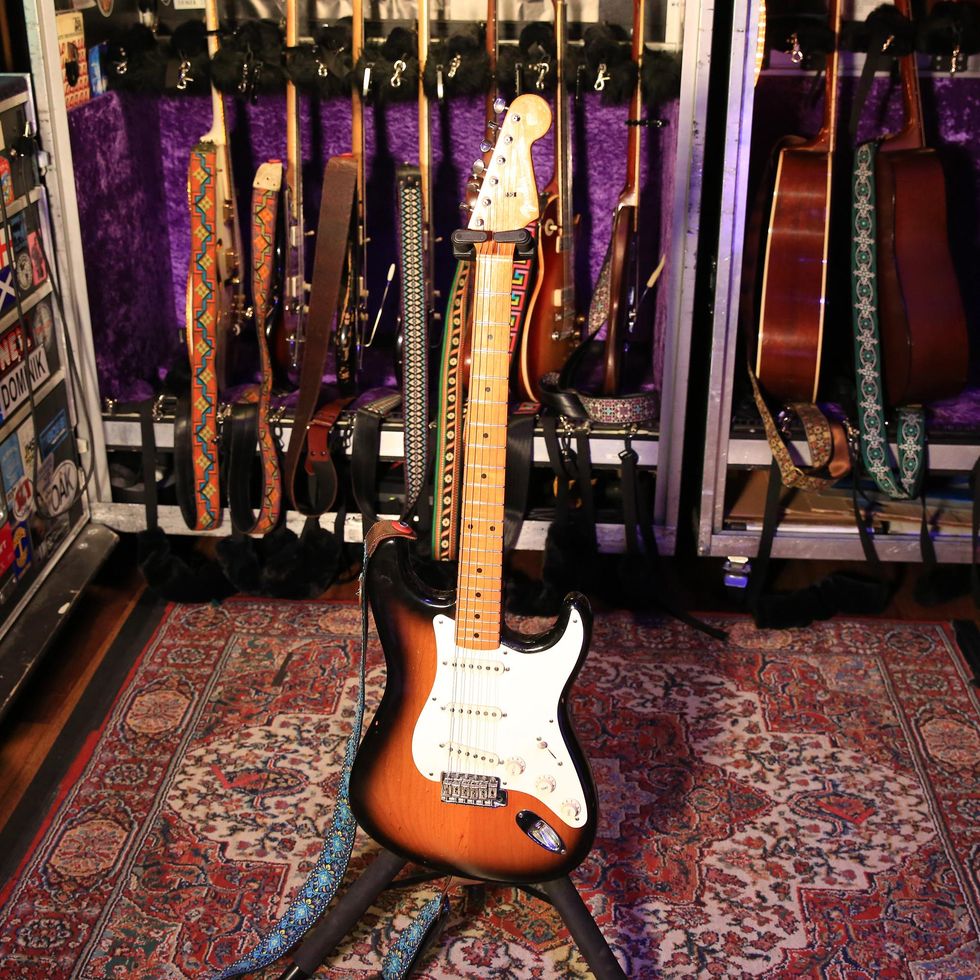
If you’re a fan of Rig Rundowns or Kurt Vile & the Violators, you’ve already seen this Strat. The above Fender American Vintage ’57 reissue was once owned by Jesse Trbovich, who’s flanked Vile for years. Trbovich landed a true-blue ’70s Olympic white Strat and needed to unload this to make room. Granduciel quickly raised his hand as a landing spot because he really enjoyed how comfortably the neck played. And since bonding with it, he likes its low-output single-coils because he can “juice it with pedals.” (It’s worth noting that Trbovich put in a Seymour Duncan Antiquity II Strat Surfer Series in the middle position, allowing him to have hum-canceling operation in the second and fourth position.) All of Granduciel’s electrics take Ernie Ball 2220 Power Slinkys (.011–.048).
It’s the One
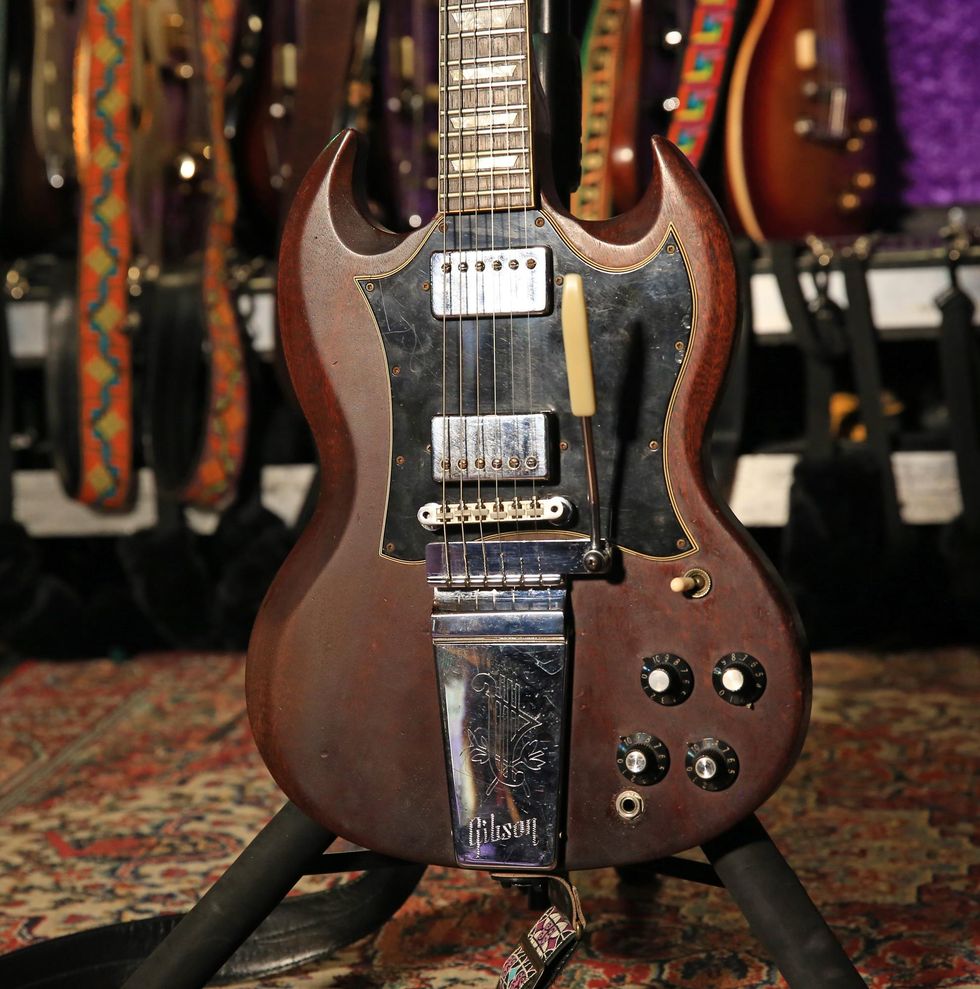
“When this thing is in my hands, I can react with it, and it becomes this whole other animal. It can be unwieldy, but this guitar plugged into a cranked Princeton or small tweed sounds incredible,” allows Granduciel. So, as you can imagine, this 1969 Gibson SG is Adam’s right-hand when it comes to recording, but, as he explains later in the video, it doesn’t coexist pleasantly with his live setup. He scooped this gem at Rivington Guitars in New York City.
Story Time
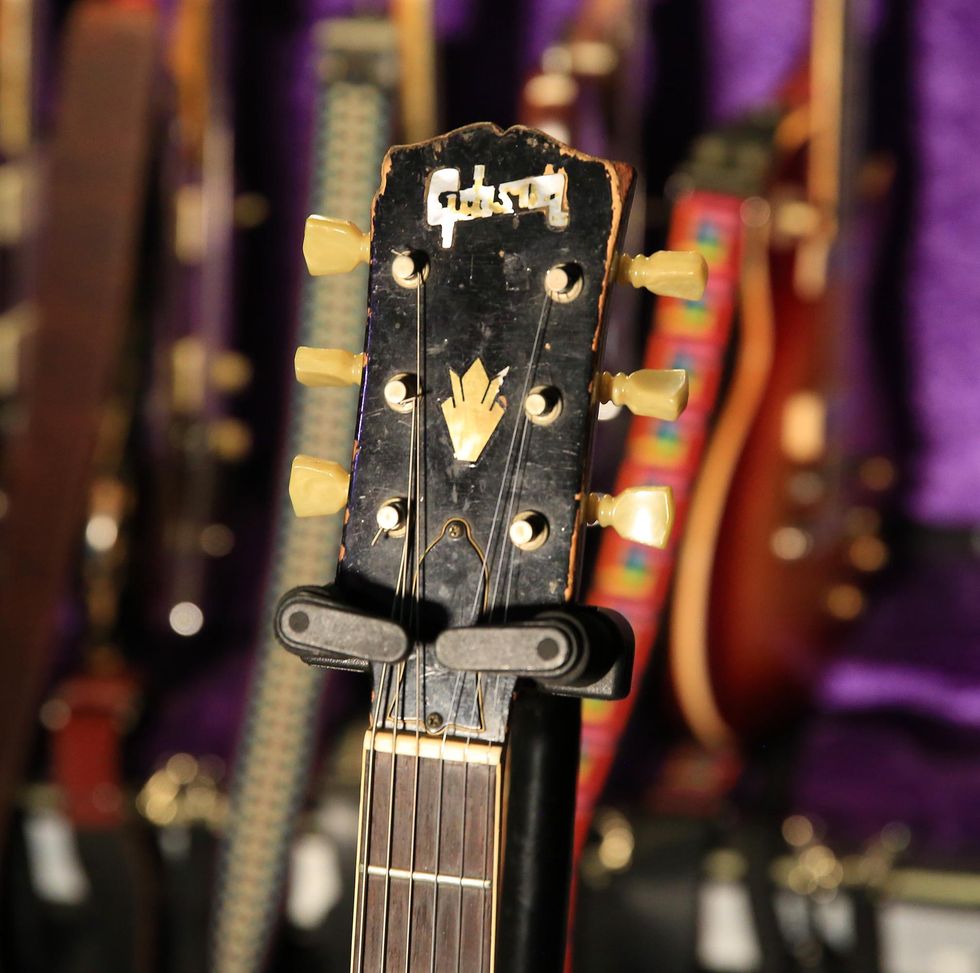
This SG’s headstock has a library of tales it is sitting on.
Flip a Coin
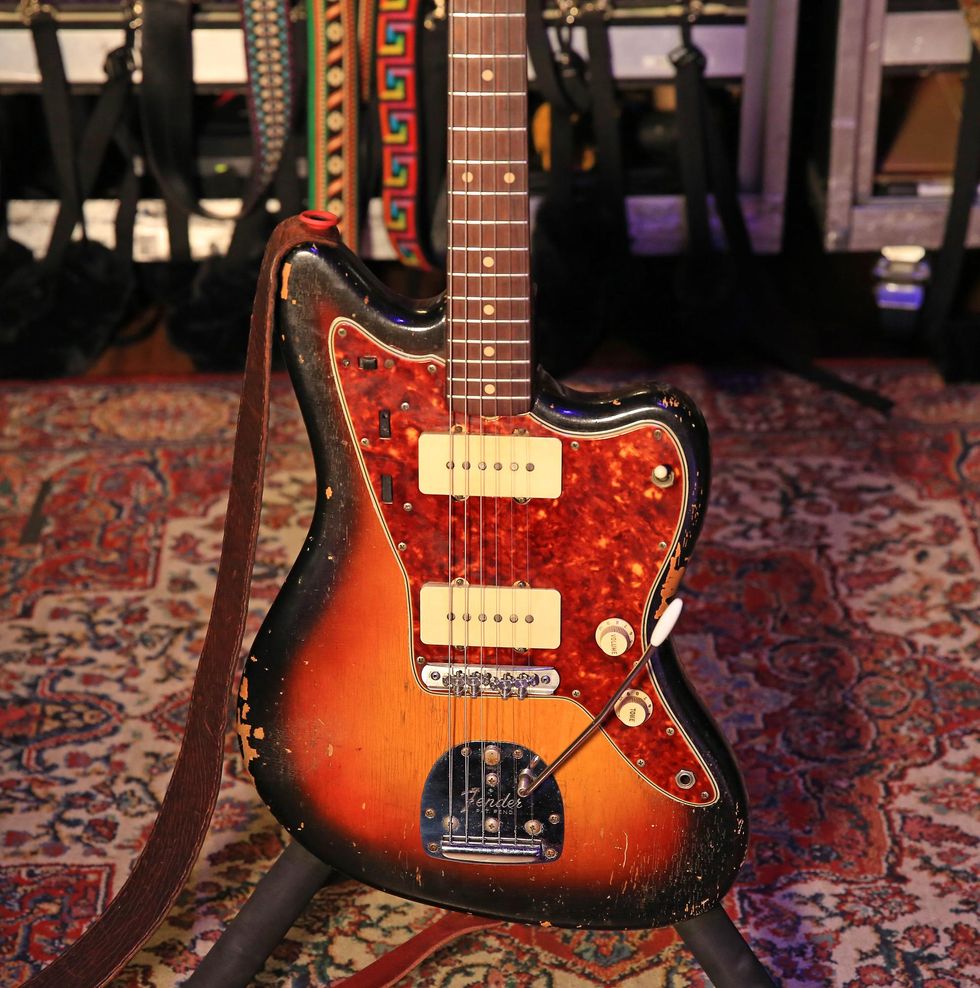
Granduciel had lusted after this vintage offset for weeks when seeing it listed on Reverb by Chelsea Guitars. The listing was removed and he thought that it was gone forever. A few months later, he was in NYC and decided to stop into the shop and, low and behold, the sunburst Jazzmaster was on their bench in pieces. Apparently, the original buyer from the Reverb listing was after a birth-year model (1964, as listed on the Reverb page), but when he removed the neck its pocket revealed a 1963 date. He traded in the guitar for a proper ’64 and, fatefully, Granduciel didn’t let a second pass before offering to buy it. Alongside the SG, this is another heavy hitter for recording.
Down Under with Terry
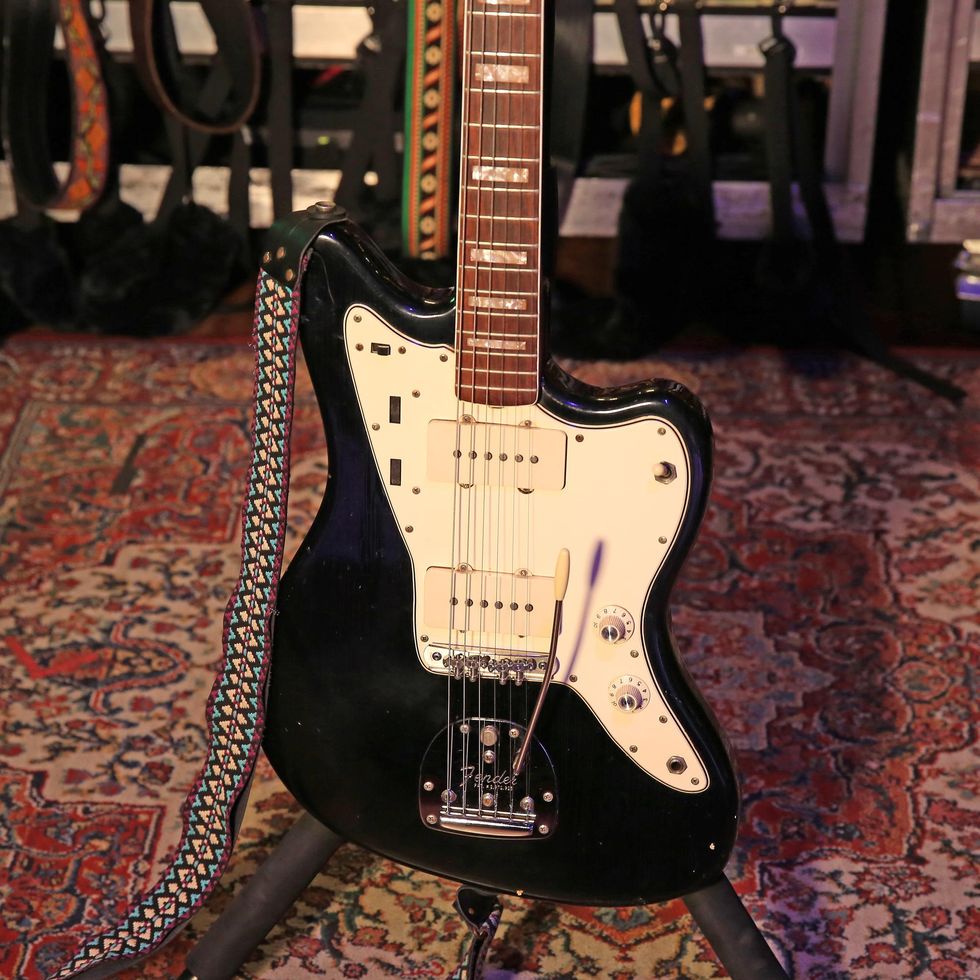
During a 2018 tour of Australia, Granduciel scored this 1966 Fender Jazzmaster that looks swanky with a matching black headstock. He claims the rhythm circuit in this one “sounds killer,” while the lead circuit is “super bright and used on ‘Occasional Rain.’” In addition to being a remarkable instrument, he loves that it reminds him of a short span of time that included a wonderful tour of Down Under, earning a Grammy for Best Rock Album, and the Philadelphia Eagles winning the Super Bowl.
Checked Past
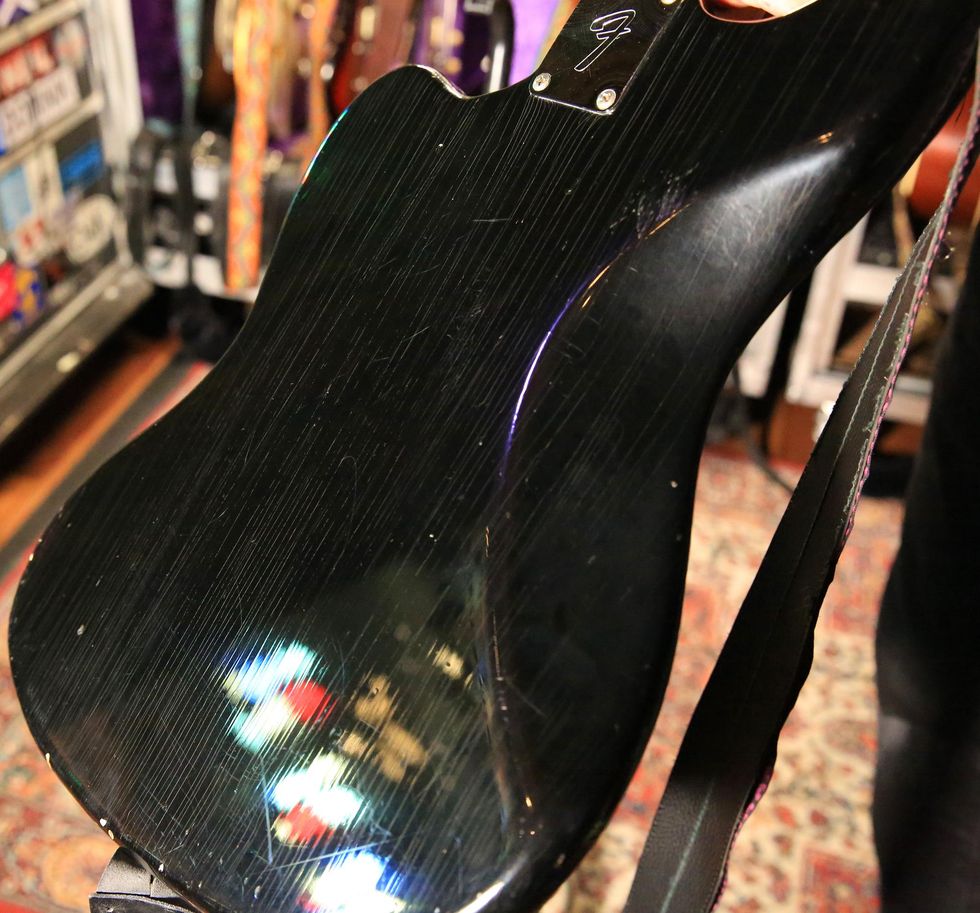
Cracks aren’t meant to be beautiful, especially on guitars, but looking at the ’66’s backside reveals a twisted thumbprint.
Fly, Firebird Fly
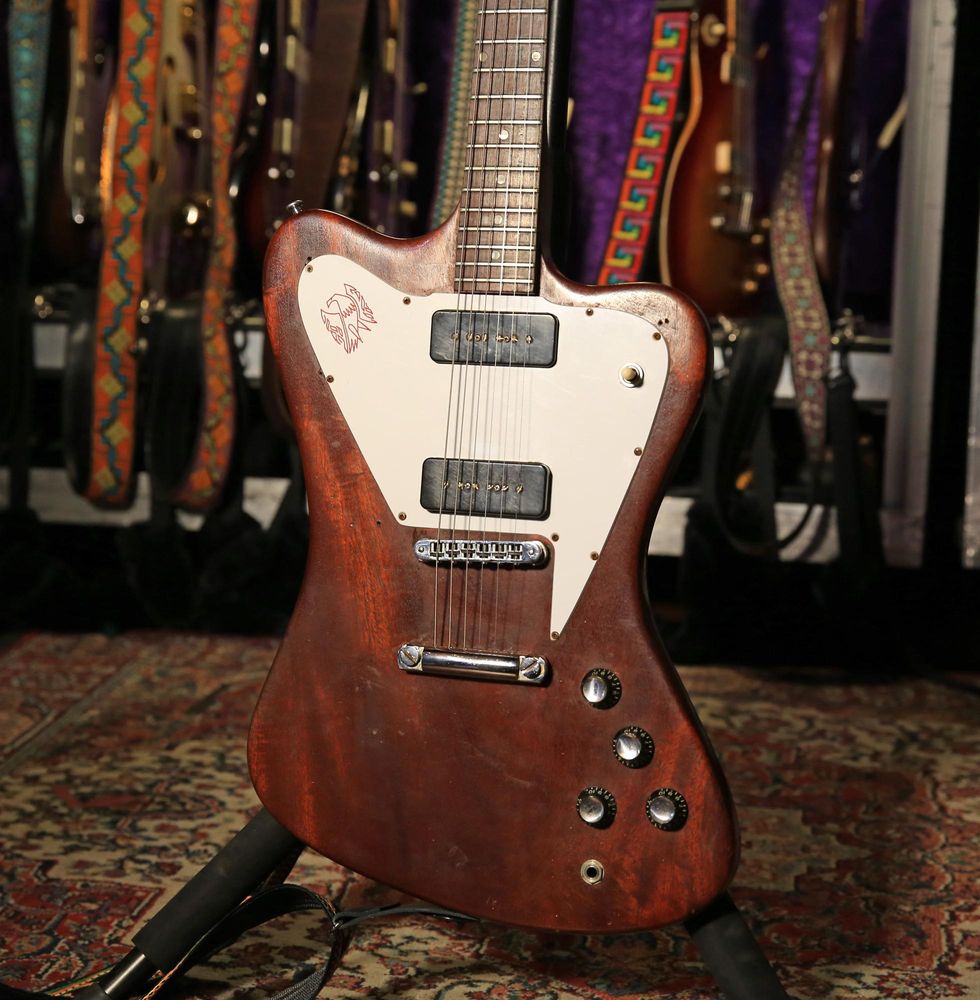
This 1965 non-reverse Firebird was upgraded by its previous owner with a set of Lollar P-90s. If you recall the last Rundown with TWOD, Granduciel added a Bigsby, but that has since been removed.
Ol’ Reliable
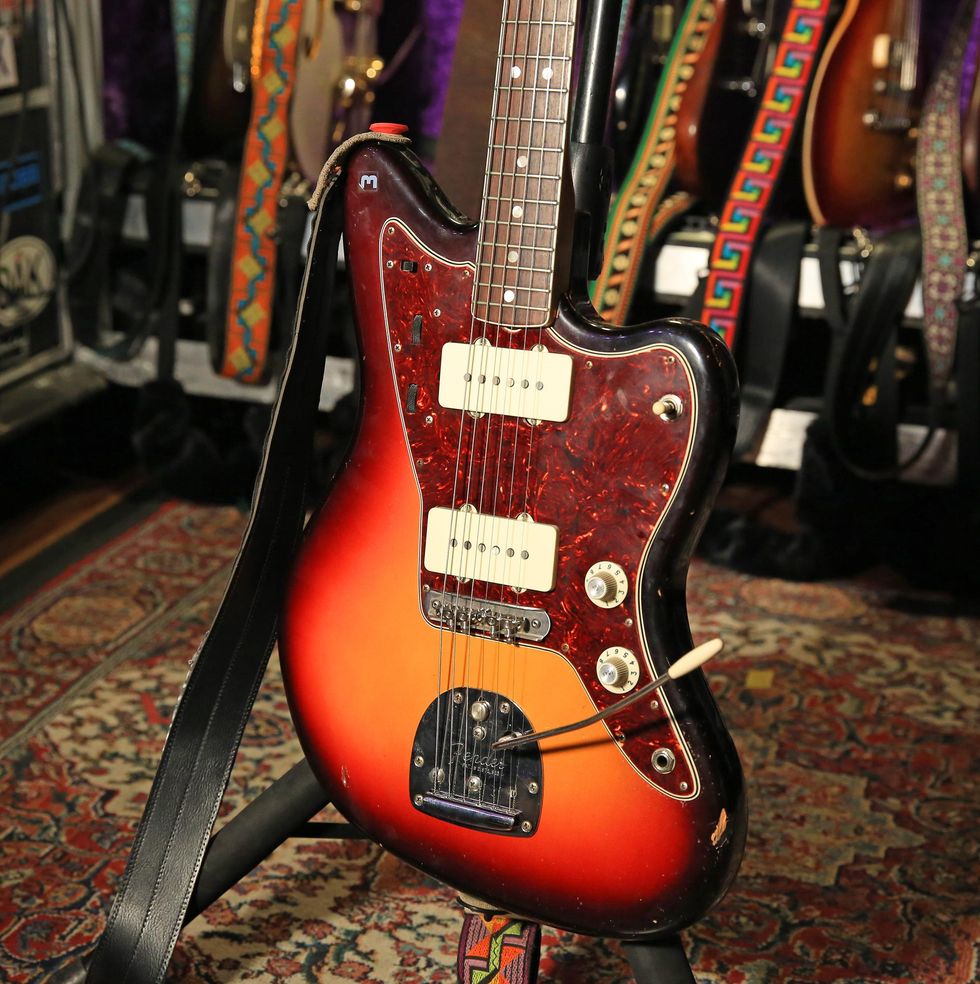
This Fender American Vintage ’65 Jazzmaster has been a dependable dynamo for Adam. He prefers it because he knows what he’s going to get sonically and he can throw it around without worry. The newer pickups offer a snarlier tone, so it gets used for songs like “Pain,” and the top-end sear helps him cut through the seven-piece live band.
Hummingbird Season
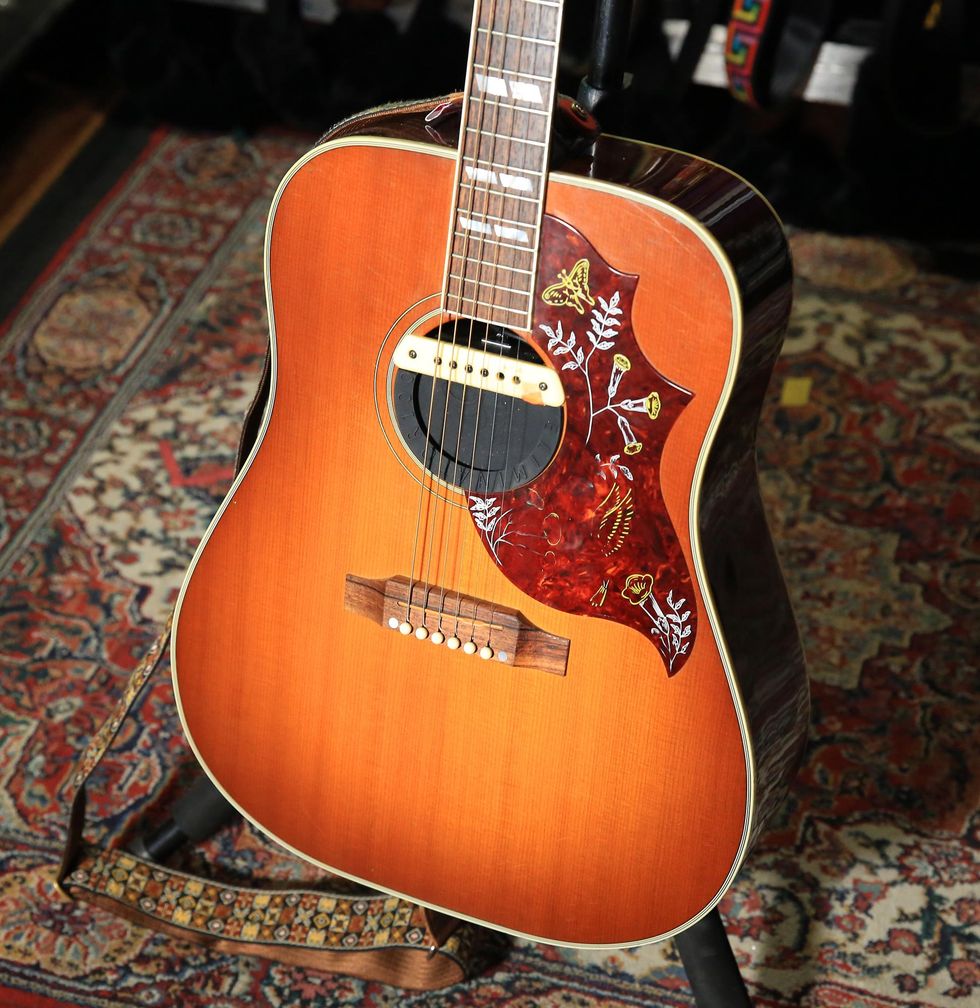
This new-ish Gibson Hummingbird gets busted out for C# tunes and features a LR Baggs M1 soundhole pickup.
Bastion of Tone
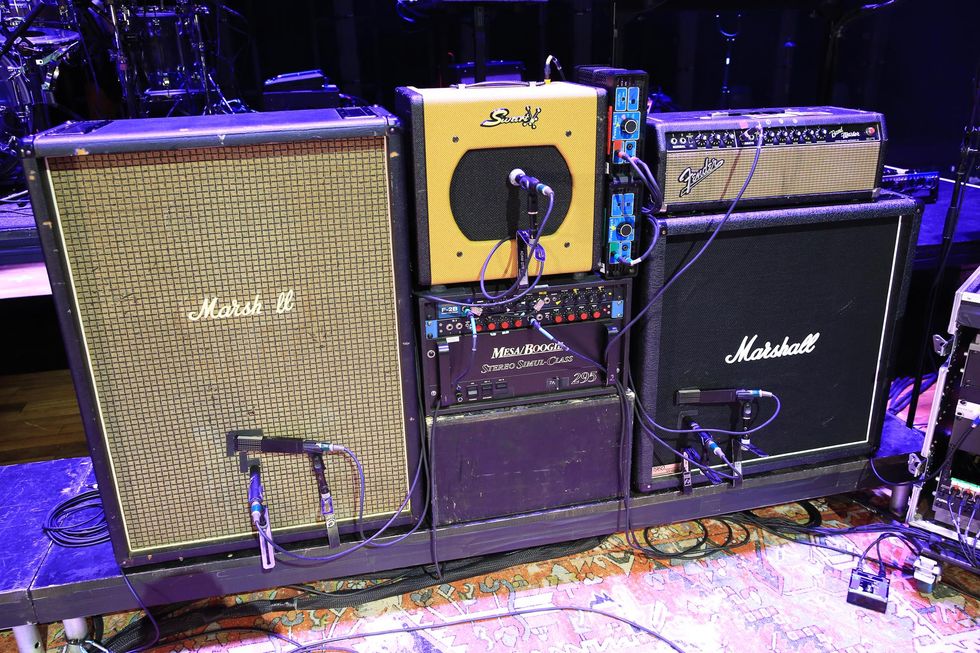
Not quite the famed Wall of Sound procured by the Dead and audio engineer Owsley “Bear” Stanley, but Granduciel’s evolving setup is heading in that direction.
Alembic Ace
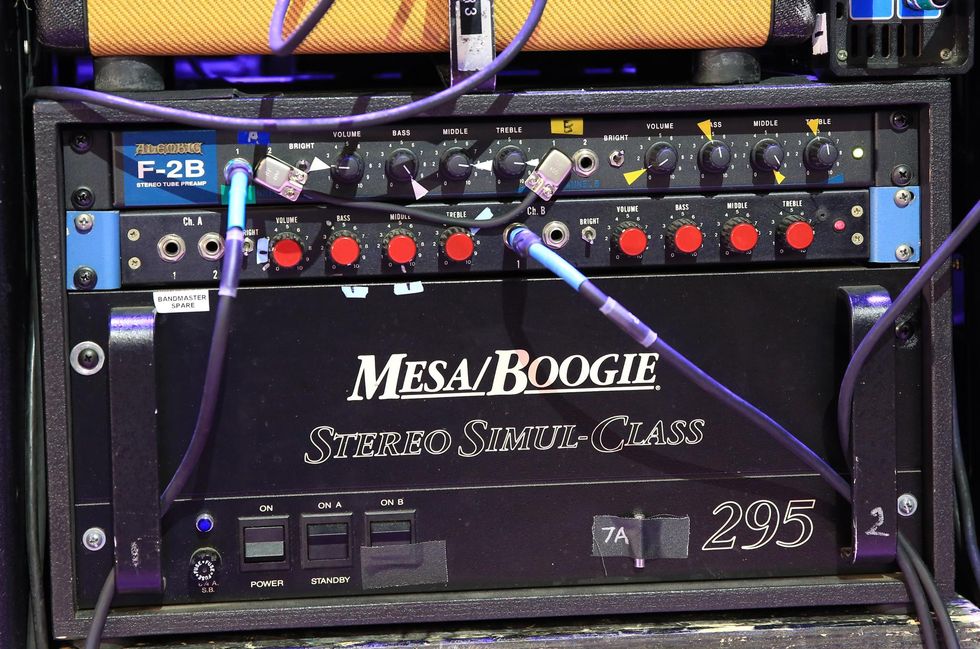
Since our last Rundown, Adam has ditched the Hiwatts (although he admits to enjoying that era of TWOD) for the Alembic F-2B Stereo Preamp that was used by Jerry Garcia and David Gilmour. He describes its circuity as mimicking the front end of a Fender Dual Showman. “There’s just so much clean headroom and they’re so creamy. And I don’t know what it is, but single-coils and P-90s just come to life here in a way that other amps don’t, so maybe that’s why Jerry and David used them so much.” The Mesa/Boogie Stereo Simul-Class 295 powers the Alembic. He does run a direct line signal from the F-2B to FOH for a clean DI option.
Take a Guess
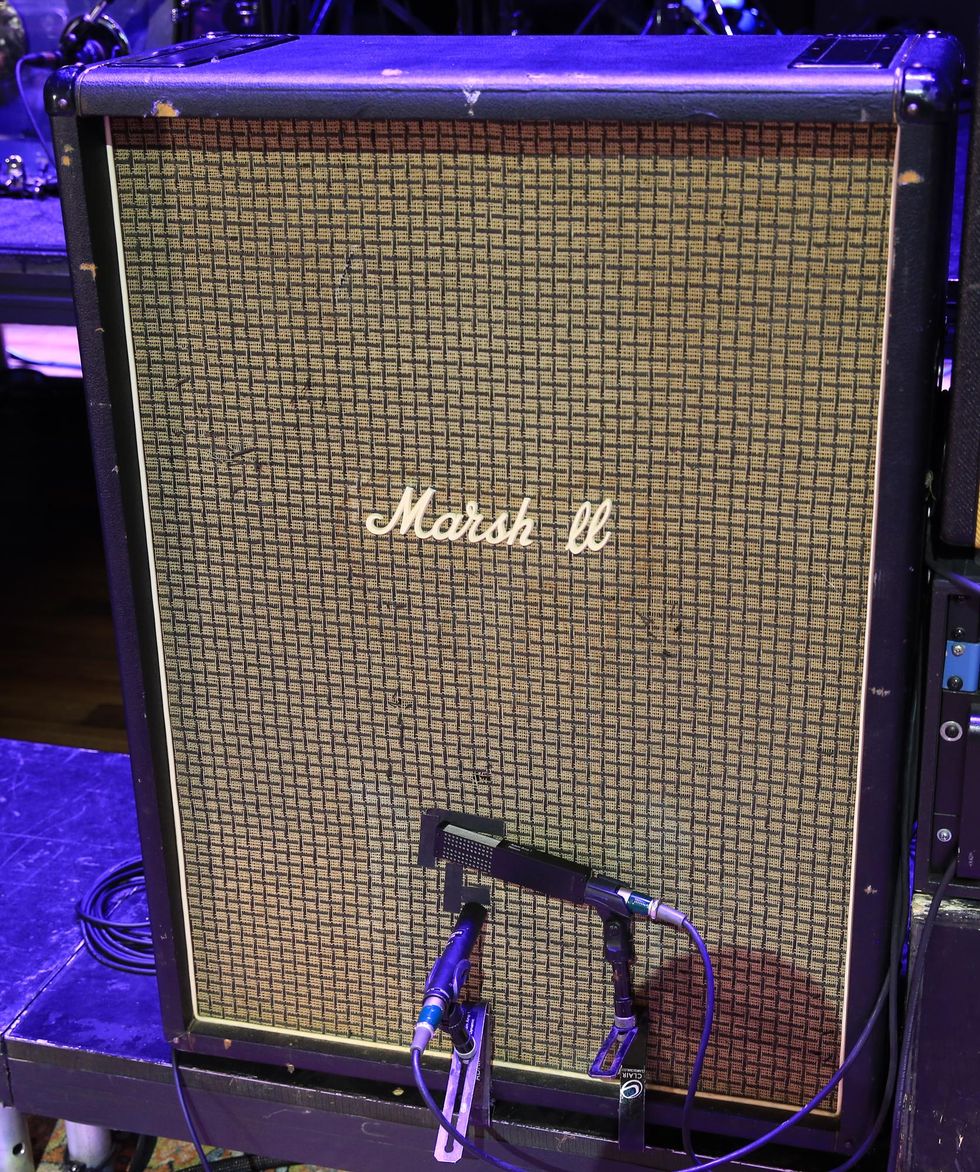
In the video, Granduciel challenged me to guess how many speakers are in the oversized cab, and I said four. Seemed logical but, as he quickly pointed out, the Marshall 2041 Lead Organ has only a pair of Celestion (pre-rola) 12" speakers. The Alembic runs through this pillar of power.
Fender Firepower
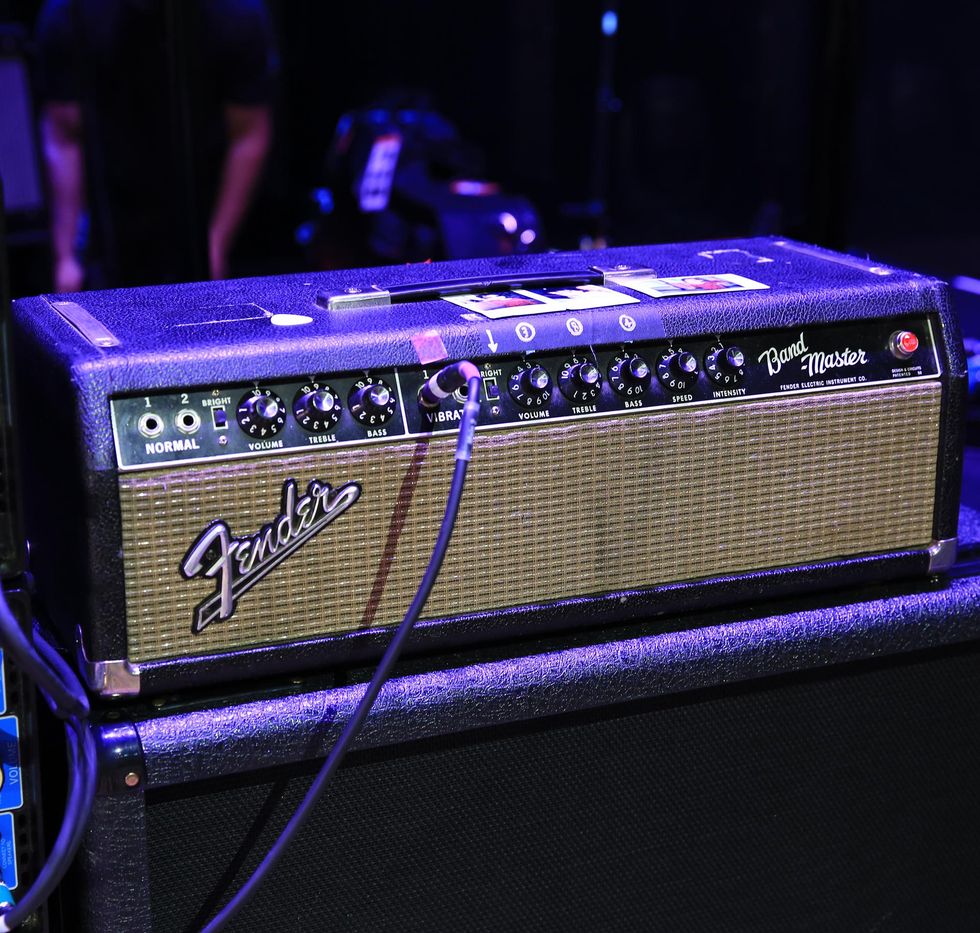
The other side of Adam’s grand equation is a 1960s Fender Bandmaster head that hits a Marshall 1960BV 4x12.
The Swart Solution
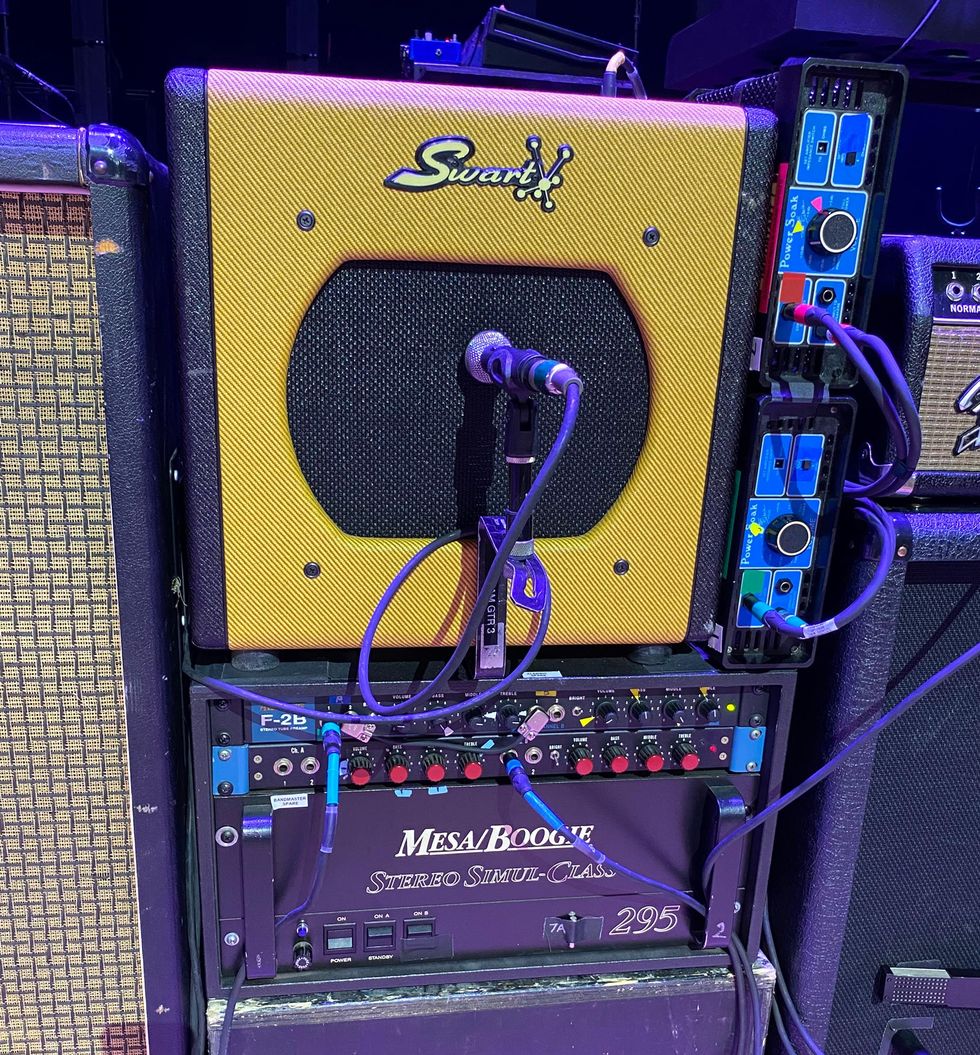
As we alluded earlier, his beloved 1969 SG doesn’t jive with his Alembic-Fender setup, so he incorporates its humbuckers into his live rig by plugging into the 5W Swart STR-Tremolo. The SG and Swart typically dance for “Thinking of a Place,” but Granduciel admits to kicking it on with the Fenders during the heat of battle and treating it like a tremolo pedal for parts of “Pressure” and other jams. To the right of the Swart you’ll notice a pair of Rockman Tom Scholz (yeah, the Boston legend) Power Soak attenuators throttling the Alembic and Fender.
Keeping Time in the Loop
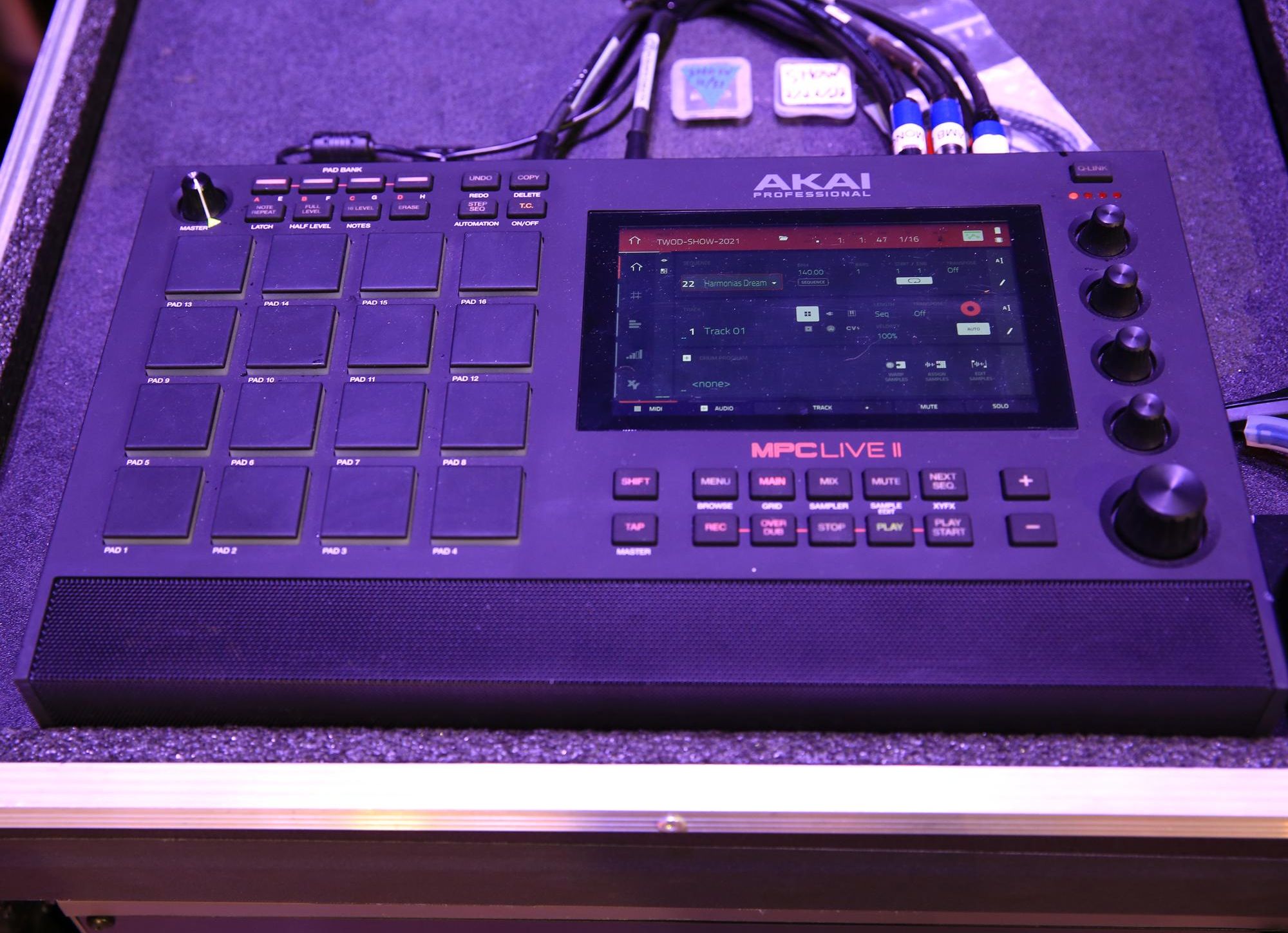
The band uses this AKAI Professional MPC Live II for additional drum machines for the show.
User Input
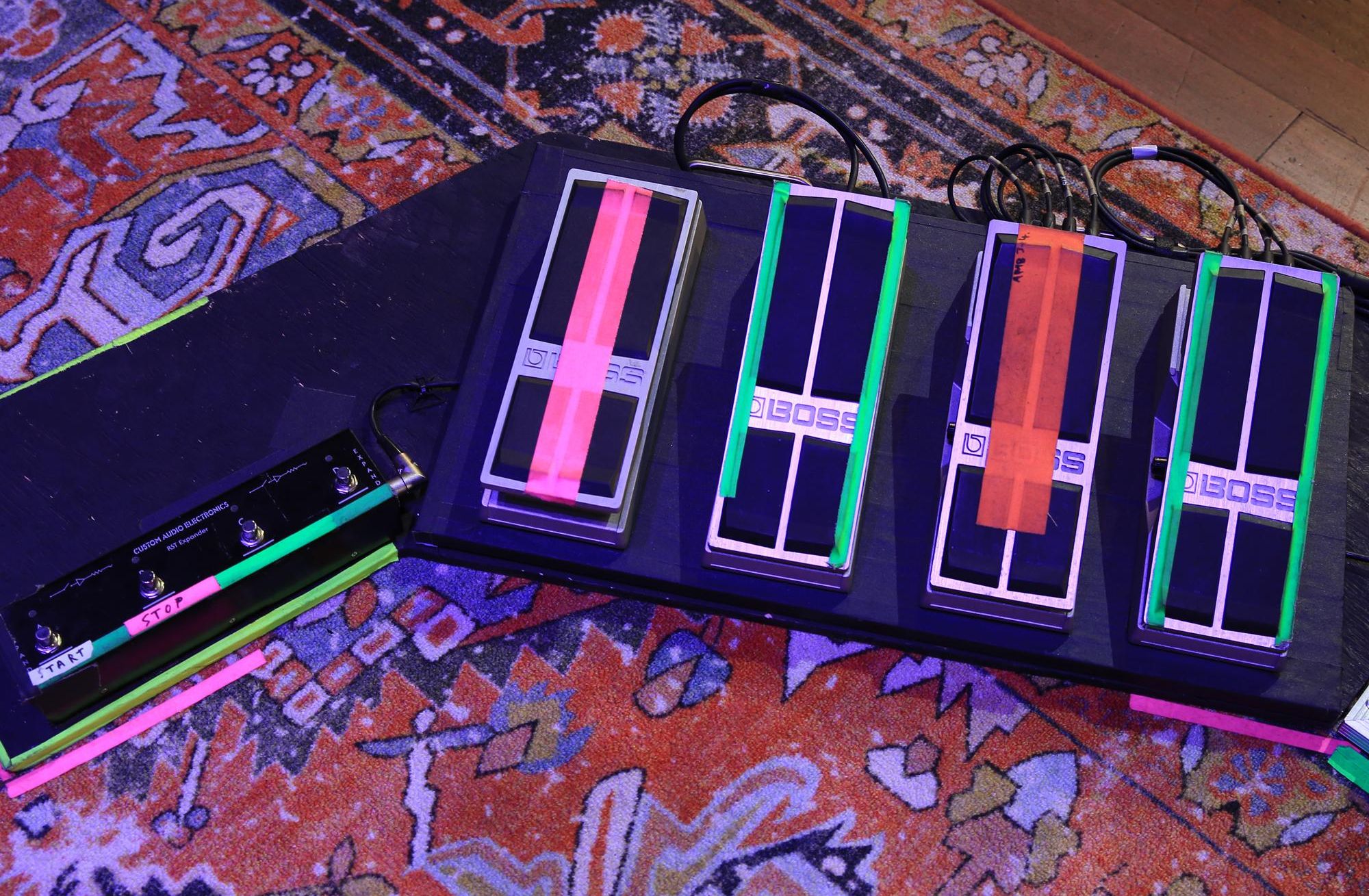
They are harnessed by four Boss FV-500L Foot Volume Pedals controlled by Adam that allow him to bring the samples into the room mix. Additionally, the band syncs their modulation to it, so everyone is locked in. (The MPC clocks or syncs the pulsing of the tremolo for the band. Adam uses a Lightfoot Labs Goatkeeper 2, while bassist David Hartley uses a Malekko Goatkeeper.)
Horseshoe of Madness
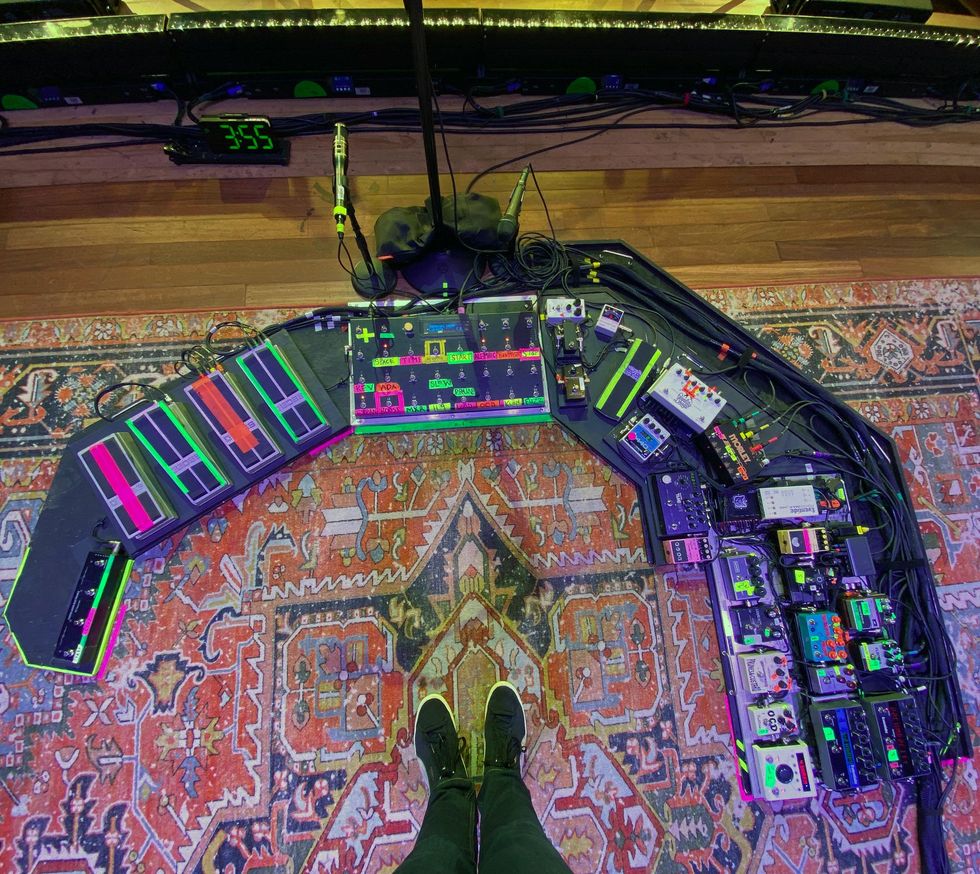
Here’s a crow’s-nest view of Adam Granduciel’s massive pedal playground.
Bradshaw’s Boardroom
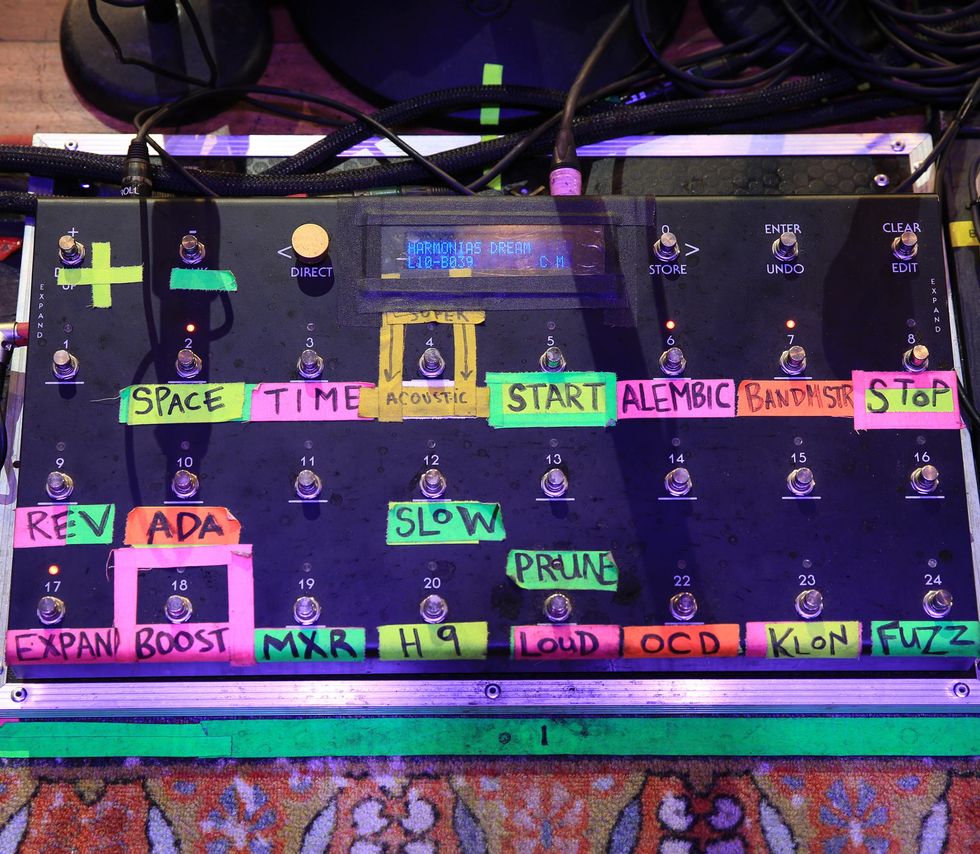
Most of what Adam does with his feet is simplified by this Custom Audio Electronics R-ST 24 + 2x PSS MIDI controller.
The Fun Begins
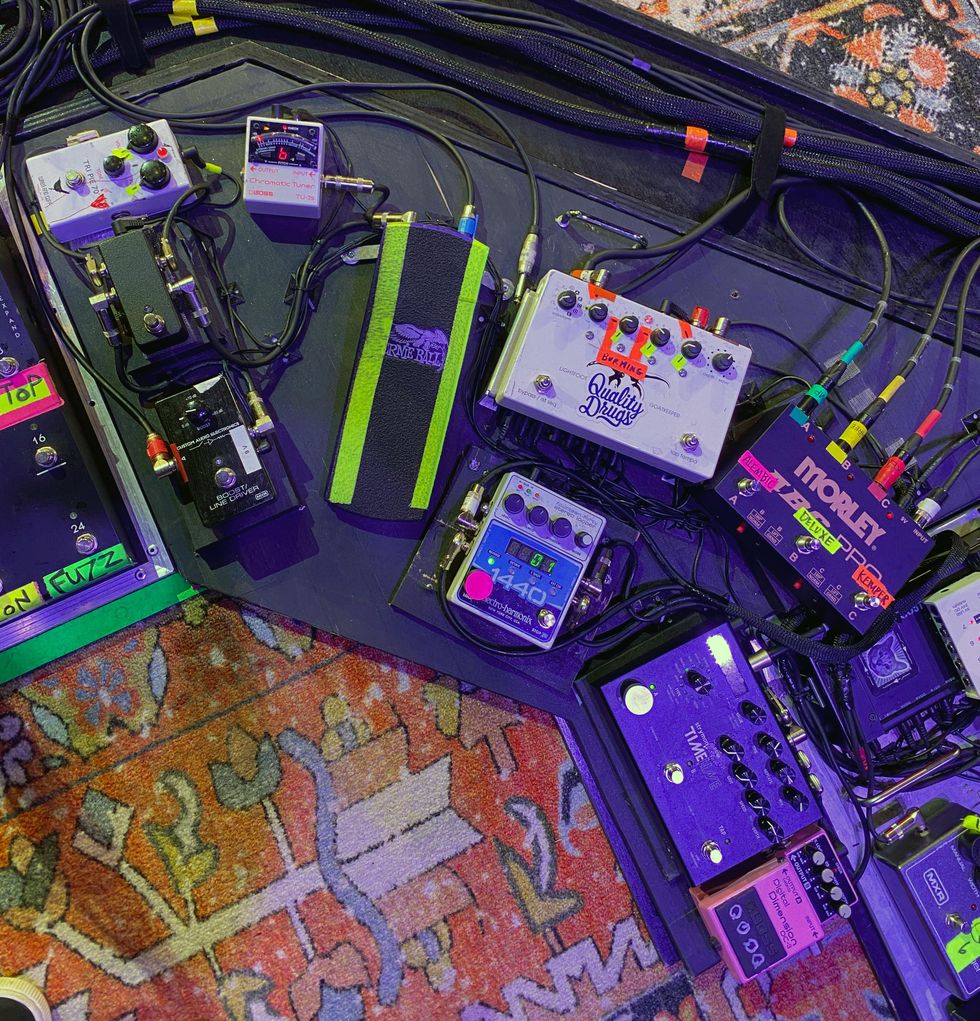
Here’s one of the sections of Granduciel’s expanding pedalboard that includes a Wren and Cuff Tri Pie 70, a MXR/Custom Audio Electronics Boost/Line Driver, an Ernie Ball Expression Tremolo, anElectro-Harmonix 1440 Stereo Looper, a Lightfoot Labs Goatkeeper 2, a Strymon TimeLine, a Boss DC-3 Digital Dimension, and a Morley ABC Pro (for switching amps). A Boss TU-3s Chromatic Tuner keeps his guitars in check.
To the Moon, Adam, to the Moon!
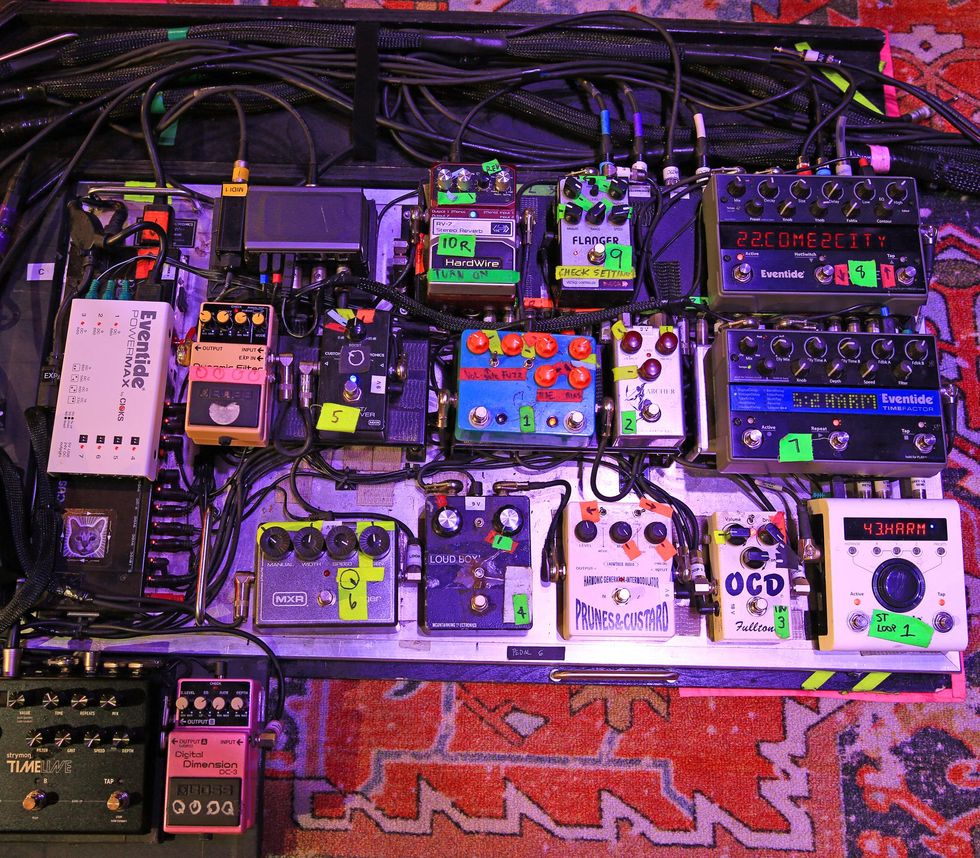
Here’s the meat and potatoes of Granduciel’s spreading stomp setup: (top left) a Boss FT-2 Dynamic Filter, another MXR/Custom Audio Electronics Boost/Line Driver, DigiTech Hardwire RV-7 Stereo Reverb, ADA Flanger, JHS Bun Runner, J. Rockett Audio Designs Archer, MXR Flanger, Moutainking Electronics Loud Box, Crowther Audio Prunes & Custard, a Fulltone OCD, and a trifecta of Eventides that rest on the right side—a Space, TimeFactor, and H9. Everything gets current by either a MXR Custom Audio Electronics MC403 Power System or the Eventide PowerMax.
Clovis the Rough Rider
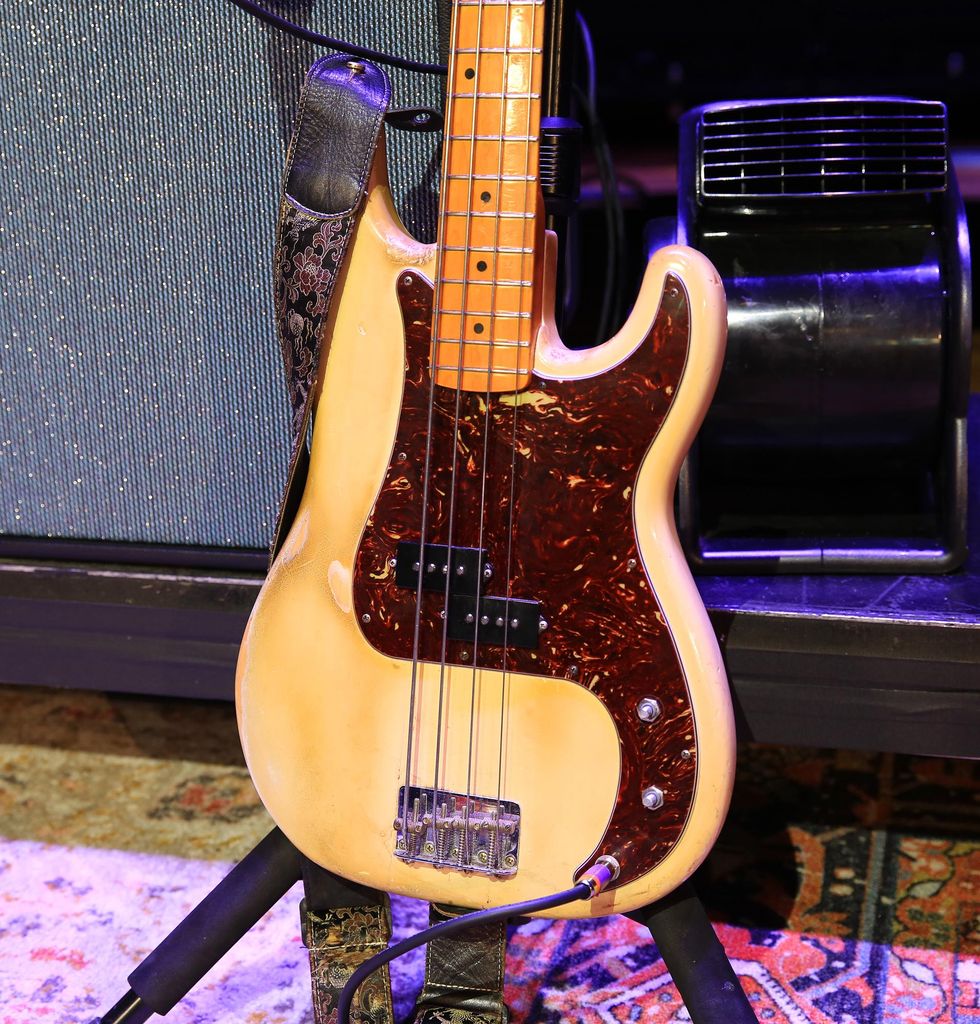
At first glance, you’d probably mistake this for a ’60s or ’70s Fender P, but as bassist David Hartley attests, this is a 2002 Fender Precision named Clovis that he acquired brand new almost two decades ago. Part of Clovis’ charm for Hartley is that it’s the lightest P he’s ever held, making their “Evening With” shows a little easier on the back. It’s stock aside from him swapping out the standard anodized gold pickguard for the tortoiseshell. He uses La Bella 760FS Deep Talkin’ Bass Flats (.045–.105).
Jam Like Jamerson
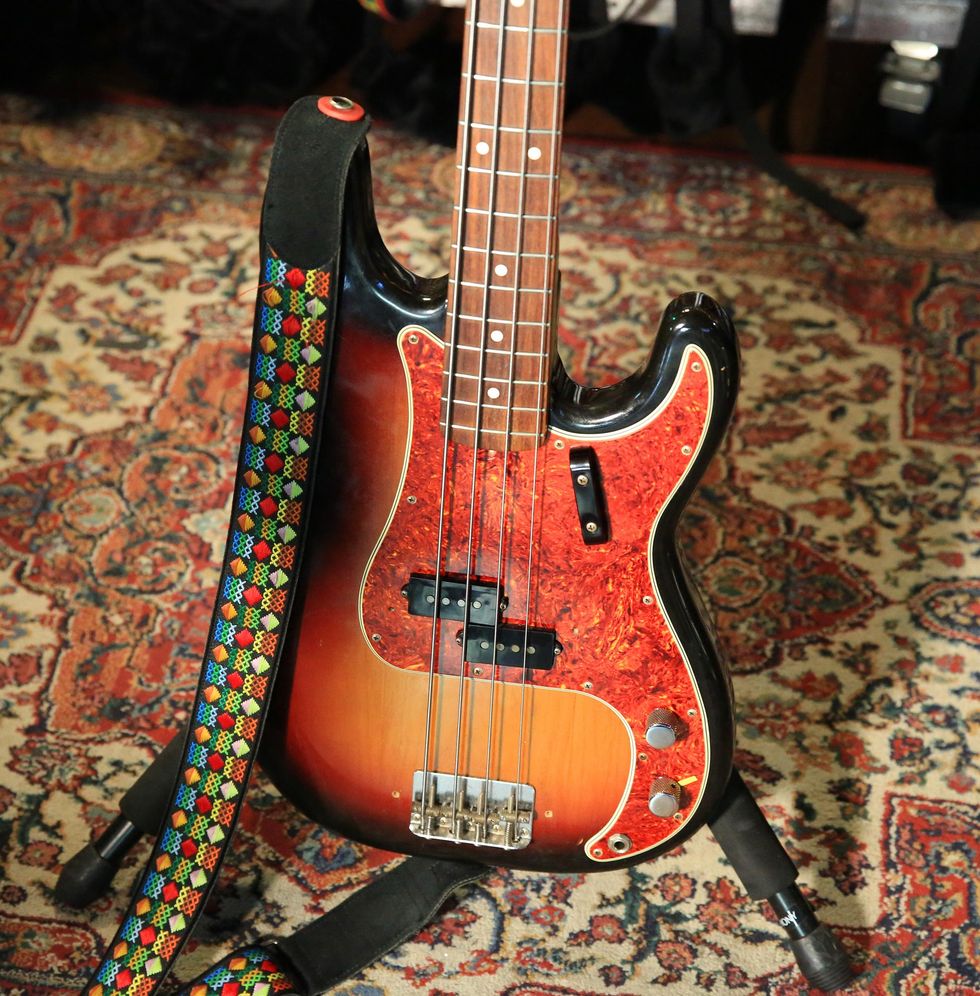
Another 4-string that does a lot of heavy lifting for Hartley is this 1983 Fender Fullerton ’62 Reissue Precision Bass. While this one isn’t as light as the previous P, he does love how much it sustains.
Find the Note
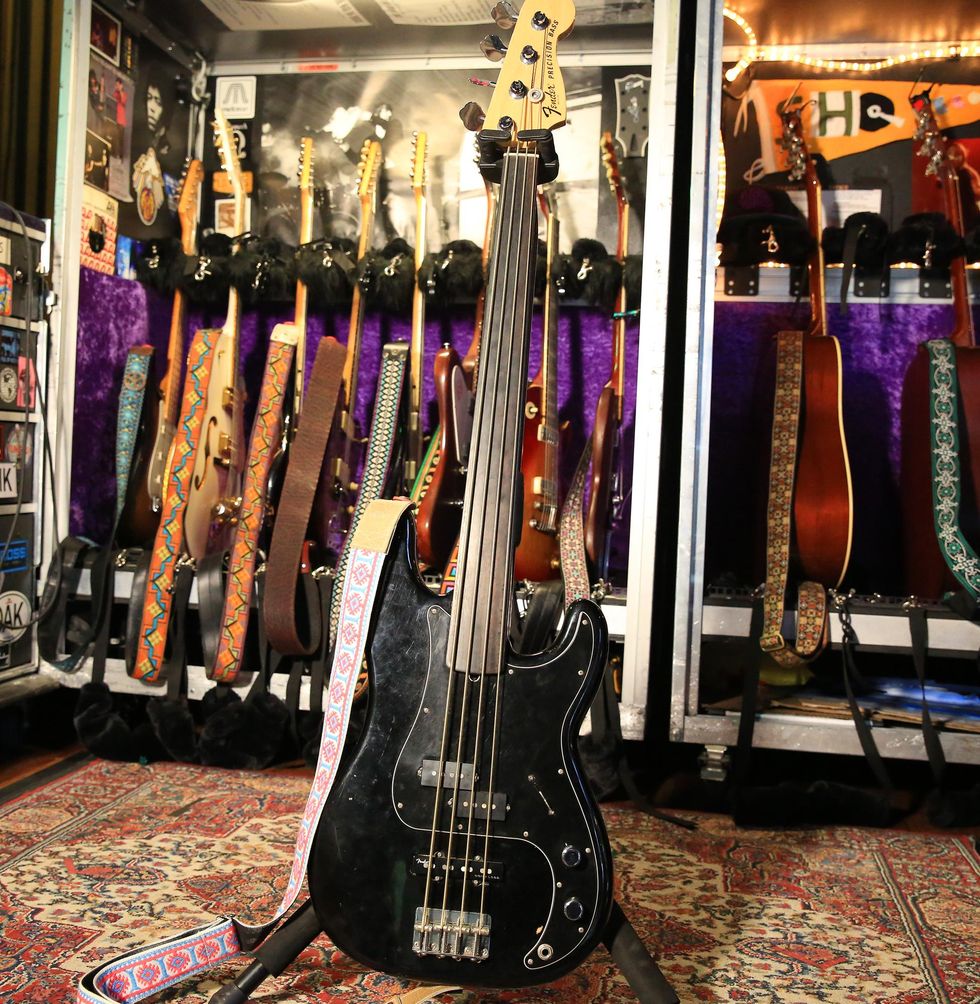
And occasionally you’ll see Hartley put down all the guardrails and dance with this Fender Tony Franklin Fretless Precision Bass. The connection with this one came through when he heard how much vocal tonality it has. It’s a highly expressive instrument.
Ampeg Assault
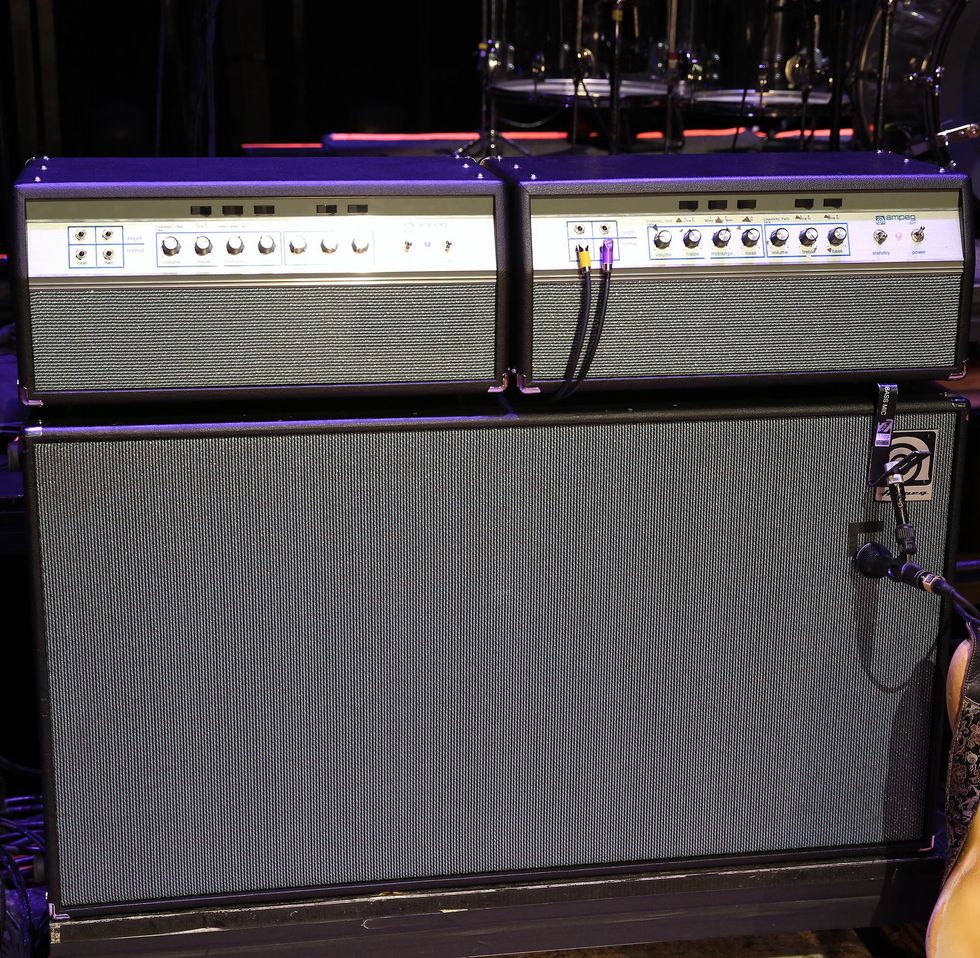
The Ps come to life thanks to this boulder of bass tone: a pair of Ampeg Heritage 50th Anniversary SVT amps that hit an Ampeg Heritage SVT-810AV. The SVT on the left is a backup and Hartley plugs into the normal channels.
Simple but Not
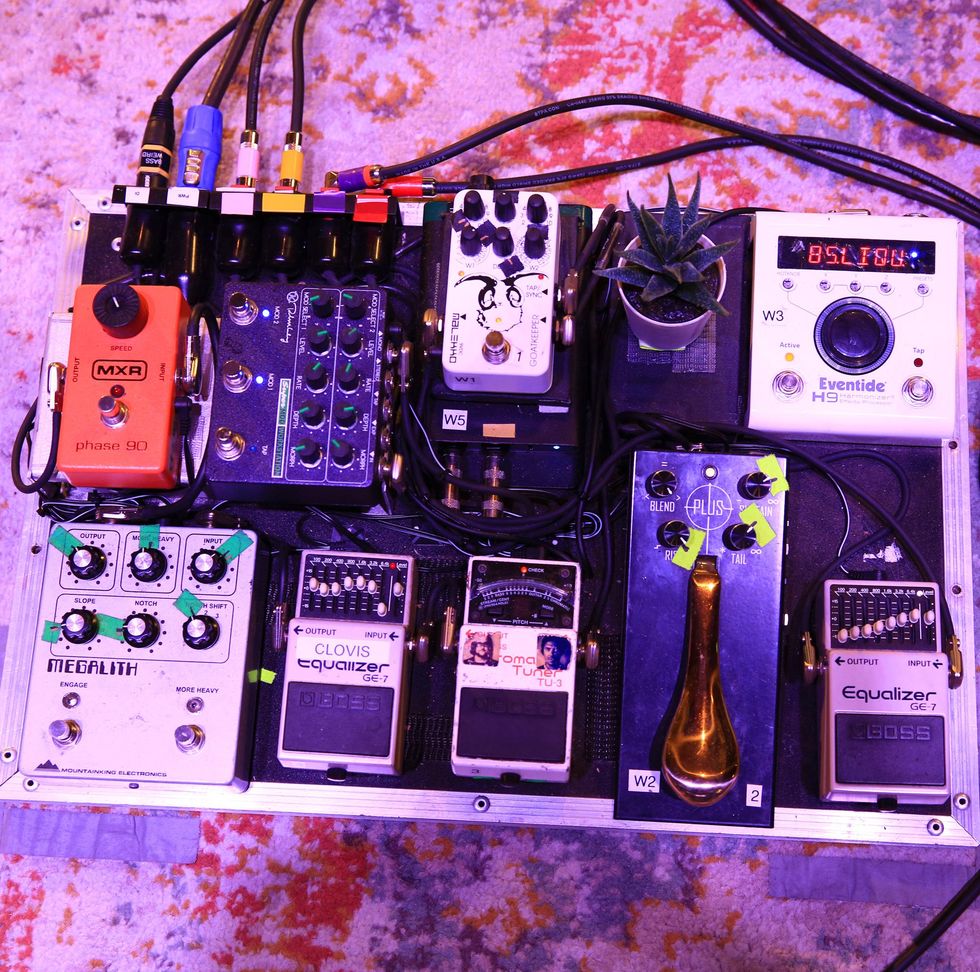
Prior to this run, Hartley toyed with the idea of just plugging his Ps into a DI and his Ampeg. Clearly, that plan changed and he’s probably having more fun because of it. His stomp station contains a pair of Boss GE-7 Equalizers (one to help Clovis pop a bit more and the other helps brighten up the ambient drone of the Gamechanger), an Eventide H9, a Gamechanger Audio Plus Sustain Pedal, a Mountainking Electronics Megalith, a Malekko Goatkeeper, a Keeley Super Mod Workstation, and a MXR Phase 90. A Boss TU-3 Chromatic Tuner keeps his Ps sounding right.
![Rig Rundown: The War on Drugs [2022]](https://www.premierguitar.com/media-library/rig-rundown-the-war-on-drugs-2022.jpg?id=29981353&width=1200&height=675)




![Rig Rundown: AFI [2025]](https://www.premierguitar.com/media-library/youtube.jpg?id=62064741&width=1245&height=700&quality=70&coordinates=0%2C0%2C0%2C0)








 Zach loves his Sovtek Mig 60 head, which he plays through a cab he built himself at a pipe-organ shop in Denver. Every glue joint is lined with thin leather for maximum air tightness, and it’s stocked with Celestion G12M Greenback speakers.
Zach loves his Sovtek Mig 60 head, which he plays through a cab he built himself at a pipe-organ shop in Denver. Every glue joint is lined with thin leather for maximum air tightness, and it’s stocked with Celestion G12M Greenback speakers.























![Devon Eisenbarger [Katy Perry] Rig Rundown](https://www.premierguitar.com/media-library/youtube.jpg?id=61774583&width=1245&height=700&quality=70&coordinates=0%2C0%2C0%2C0)













